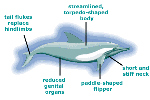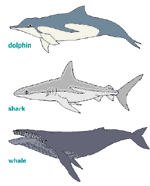 |

 Main Physical Features
Main Physical Features(Click for larger version)  Physical Differences
Physical Differences(Click for larger version)
|
Body ShapeAn examination of the profile of modern dolphins shows the extent to how mammals have actually evolved to become adapted to their aquatic environment. All dolphins have a similar streamlined, torpedo-shaped body - their bodies are larger at the front than at the back. The dolphin has a short, stiff neck. As with all the ceteceans, all visible traces of hind limbs have disappeared. The forelimbs have developed into paddle-shaped flippers which helps in steering through water. The tail of a dolphin (called the fluke) is used for propulsion: it is therefore very muscular. Many features of the former land-dwelling mammals have disappeared, for example, dolphins do not have significant body hair, an external ear lobe (pinna), a projecting nose, and externally projecting genitals or mammary glands. All their protruding parts are reduced or tucked away, so as to improve hydrodynamic efficiency. Their body shape differs very little in comparison with other ceteceans (whales and porpoises). Sometimes, dolphins are even mistaken for sharks. It is easy to distinguish between a dolphin and a shark on the surface; the latter has a vertical tail fin which projects out of the water behind the dorsal fin. Comparatively speaking, dolphins have a smaller head and shorter body than whales. Dolphins have a beak and but porpoises do not and dolphins usually have dorsal fins. | ||||
|
BibliographyHarrison, Sir Richard, et. al. Whales, Dolphins and Porpoises. New York: Facts on File, Inc., 1994. Mark Carwardine, The Book of Dolphins. Dragon's World Ltd, 1996 Tursi. "Tursi's Dolphin Page" Available http://www.neteng.bc.ca/~tursi/dolphins/index.htm, 4 September 1997, Accessed 4 April 1998 |
|
© 1998 ThinkQuest team 17963 <17963@advanced.org Modified: 30 August 1998, Created: 30 June 1998 |